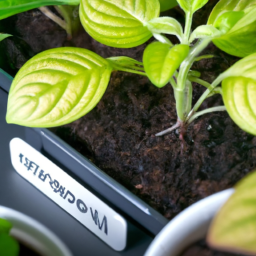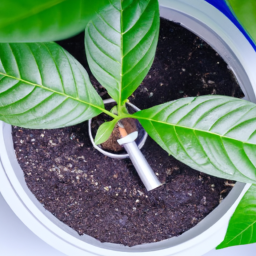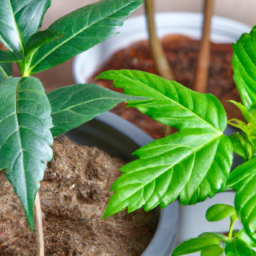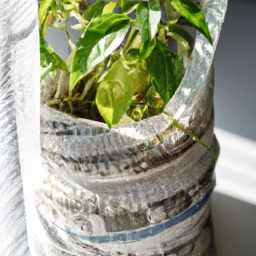
Are you a plant lover who wants to bring the beauty of nature indoors? If so, you’ve come to the right place. In this blog post, we will explore the wonderful world of indoor growing lights and how they can help you achieve healthy and vibrant plants right in the comfort of your own home. Whether you’re a seasoned gardener or just starting out, these lights are a game-changer when it comes to providing your plants with the optimal conditions they need to thrive. So, let’s dive in and discover the secrets to creating a lush and flourishing indoor garden with the help of indoor growing lights.
The Importance of Indoor Growing Lights for Healthy Plant Growth
Welcome to the world of indoor gardening! Whether you are a seasoned gardener or a beginner, understanding the importance of indoor growing lights is crucial for achieving healthy and vibrant plants. In this guide, we will delve into the benefits of using indoor growing lights, the different types available, and how to properly utilize them for optimal plant growth.
Benefits of Indoor Growing Lights
Indoor growing lights provide a viable solution for growing plants indoors, especially in spaces with limited natural light. Here are some key benefits:
1. Supplemental Light: Indoor growing lights act as a supplement to natural light, ensuring that your plants receive an adequate amount of light for photosynthesis. This is particularly important in areas with long winters or limited access to sunlight.
2. Extended Growing Season: By using indoor growing lights, you can extend the growing season and grow plants year-round. This is especially beneficial for those who live in regions with short summers or harsh climates.
3. Increased Control: Indoor growing lights allow you to have complete control over the light spectrum, intensity, and duration. This level of control enables you to tailor the lighting conditions to the specific needs of your plants, promoting healthy growth and maximizing productivity.
Types of Indoor Growing Lights
When it comes to indoor growing lights, there are several types to choose from. Let’s explore the most common ones:
1. Fluorescent Lights: Fluorescent lights are a popular choice for indoor gardening due to their affordability and energy efficiency. They come in two main types: compact fluorescent lights (CFLs) and high-output fluorescent lights (HOFLs). CFLs are suitable for seedlings and young plants, while HOFLs provide higher light intensity for mature plants.
2. LED Lights: LED lights have gained popularity in recent years due to their energy efficiency, long lifespan, and versatility. They emit light in specific wavelengths, allowing you to customize the light spectrum according to your plants’ needs. LED lights are suitable for all stages of plant growth.
3. High-Intensity Discharge (HID) Lights: HID lights are known for their high light output, making them ideal for large-scale indoor gardening. There are two types of HID lights: metal halide (MH) and high-pressure sodium (HPS). MH lights emit a bluish light spectrum, promoting vegetative growth, while HPS lights emit a reddish spectrum, stimulating flowering and fruiting.
Proper Utilization of Indoor Growing Lights
To achieve healthy and vibrant plants with indoor growing lights, follow these essential steps:
1. Determine Light Requirements: Different plants have varying light requirements. Research the specific light needs of your plants, including the ideal light intensity, duration, and spectrum for each growth stage.
2. Positioning and Hanging: Proper positioning of the lights is crucial for even light distribution. Hang the lights at an appropriate height, ensuring they are close enough to the plants without causing heat stress. Adjust the height as the plants grow to maintain the optimal distance.
3. Light Schedule: Establish a consistent light schedule to mimic natural sunlight. Most plants require 12-16 hours of light per day for vegetative growth and 8-12 hours for flowering and fruiting. Use timers to automate the light schedule and maintain consistency.
4. Light Intensity: Adjust the light intensity based on the growth stage of your plants. Seedlings and young plants require lower light intensity, while mature plants need higher intensity. Refer to the manufacturer’s guidelines for recommended light intensity levels.
5. Light Spectrum: Customize the light spectrum according to your plants’ needs. For vegetative growth, use lights with a higher blue spectrum, while for flowering and fruiting, switch to lights with a higher red spectrum. LED lights provide the flexibility to adjust the spectrum easily.
6. Monitor and Adjust: Regularly monitor your plants’ response to the indoor growing lights. Look for signs of stress, such as wilting or yellowing leaves, and adjust the light conditions accordingly. Experiment with different settings to find the optimal lighting setup for your specific plants.
By following these steps and understanding the importance of indoor growing lights, you are on your way to achieving healthy and vibrant plants in your indoor garden. Remember to continuously educate yourself on the specific light requirements of your plants and adapt your lighting setup accordingly. Happy gardening!

Choosing the Right Indoor Growing Lights for Optimal Plant Health
Introduction
Indoor gardening has gained immense popularity in recent years, allowing plant enthusiasts to cultivate a wide variety of plants regardless of the outdoor climate. One crucial aspect of successful indoor gardening is providing the right lighting conditions for your plants. In this guide, we will delve into the world of indoor growing lights and explore how to choose the right ones to achieve healthy and vibrant plants.
Understanding Plant Lighting Needs
To select the ideal indoor growing lights, it is essential to understand the lighting needs of your plants. Light is the primary source of energy for plants, enabling photosynthesis, the process through which plants convert light into glucose and oxygen. Different plants have varying light requirements, including the intensity, duration, and spectrum of light they need.
Light Intensity
The intensity of light refers to the amount of light energy reaching the plants’ leaves. It is measured in foot-candles or lux. High-light plants, such as succulents and cacti, require intense light, usually around 5000 to 10000 foot-candles. Medium-light plants, like herbs and vegetables, thrive under 2000 to 5000 foot-candles. Low-light plants, including ferns and some tropical species, can survive with as little as 500 to 2000 foot-candles.
Light Duration
The duration of light exposure is equally important for plant growth. Just like humans, plants need a balance between light and darkness to thrive. Most plants require around 12 to 16 hours of light per day during the vegetative stage, while flowering plants may need shorter light periods of 8 to 12 hours. It is crucial to mimic the natural daylight cycle for optimal plant health.
Light Spectrum
Plants utilize different parts of the light spectrum for photosynthesis. While sunlight provides a full spectrum of light, indoor growing lights can be tailored to specific spectrums. The two primary spectrums of light that plants need are blue light (400-500 nm) and red light (600-700 nm). Blue light promotes vegetative growth, while red light stimulates flowering and fruiting. Many modern LED grow lights offer customizable spectrums to cater to different plant growth stages.
Types of Indoor Growing Lights
Now that we understand the lighting needs of plants, let’s explore the different types of indoor growing lights available:
1. Fluorescent Lights
Fluorescent lights are a popular choice for indoor gardening due to their affordability and energy efficiency. They come in two main types: compact fluorescent lights (CFLs) and high-output fluorescent lights (HOFLs). CFLs are suitable for low-light plants or as supplemental lighting, while HOFLs provide higher light intensity for more demanding plants. Fluorescent lights emit a balanced spectrum of light, making them suitable for various growth stages.
2. High-Intensity Discharge (HID) Lights
HID lights are known for their high light output, making them ideal for large-scale indoor gardens or commercial setups. There are two common types of HID lights: metal halide (MH) and high-pressure sodium (HPS) lights. MH lights emit a bluish-white light spectrum, perfect for the vegetative stage, while HPS lights produce a reddish-orange spectrum, ideal for flowering and fruiting. HID lights require proper ventilation and cooling due to their heat output.
3. LED Grow Lights
LED grow lights have gained significant popularity in recent years due to their energy efficiency and customizable light spectrums. Unlike fluorescent and HID lights, LEDs produce less heat, reducing the risk of burning plants. They also allow users to adjust the light spectrum according to the plant’s growth stage. While LED grow lights may have a higher upfront cost, their long lifespan and energy efficiency make them a cost-effective choice in the long run.
Choosing the Right Indoor Growing Lights
Now that you are familiar with the different types of indoor growing lights, here are some key factors to consider when choosing the right lights for your indoor garden:
1. Plant Type and Growth Stage
Consider the specific lighting needs of your plants and their growth stage. High-light plants, such as tomatoes or peppers, will benefit from high-intensity lights like HPS or LED grow lights. Low-light plants, such as ferns or orchids, can thrive under fluorescent lights. Ensure the light spectrum is suitable for the growth stage, providing blue light for vegetative growth and red light for flowering and fruiting.
2. Available Space
Evaluate the size and layout of your indoor garden space. Fluorescent lights are compact and versatile, making them suitable for small spaces or as supplemental lighting. HID lights require more space and proper ventilation due to their heat output. LED grow lights are available in various sizes and shapes, allowing for easy customization according to your space requirements.
3. Energy Efficiency
Consider the energy efficiency of the indoor growing lights. LED grow lights are known for their energy-saving capabilities, consuming significantly less electricity compared to fluorescent or HID lights. Although LEDs may have a higher upfront cost, their energy efficiency can lead to substantial long-term savings on electricity bills.
4. Budget
Set a budget for your indoor growing lights. While fluorescent lights are the most affordable option, they may not provide sufficient intensity for high-light plants. HID lights offer high performance but come with a higher price tag. LED grow lights are a mid-range option, providing a balance between performance and cost-effectiveness. Consider your budget constraints and choose accordingly.
Conclusion
Selecting the right indoor growing lights is crucial for achieving healthy and vibrant plants in your indoor garden. Understand your plants’ lighting needs, including intensity, duration, and spectrum. Evaluate the different types of lights available, such as fluorescent, HID, and LED grow lights, considering factors like plant type, available space, energy efficiency, and budget. By choosing the optimal indoor growing lights, you can create an ideal environment for your plants to flourish and thrive. Happy gardening!

Tips and Techniques for Maximizing Plant Vibrancy with Indoor Growing Lights
Welcome to the world of indoor gardening, where you can cultivate healthy and vibrant plants all year round. One of the key factors in achieving optimal plant growth indoors is providing them with the right amount and quality of light. In this article, we will explore some tips and techniques to help you maximize plant vibrancy using indoor growing lights.
Understanding the Importance of Indoor Growing Lights
Before we dive into the tips and techniques, let’s first understand why indoor growing lights are crucial for plant health and vibrancy. In nature, plants thrive under sunlight, which provides them with the full spectrum of light necessary for photosynthesis. However, indoors, natural light is often limited, especially during the winter months or in spaces with minimal windows.
This is where indoor growing lights come in. These artificial light sources mimic the sun’s spectrum, providing plants with the necessary light energy for photosynthesis. By using indoor growing lights, you can extend the growing season, create optimal growing conditions, and ensure your plants receive the right amount and quality of light they need to thrive.
Now, let’s explore some tips and techniques to help you maximize plant vibrancy with indoor growing lights.
1. Choose the Right Type of Indoor Growing Lights
There are several types of indoor growing lights available, including fluorescent, LED, and high-intensity discharge (HID) lights. Each type has its own advantages and considerations, so it’s essential to choose the right one for your specific needs.
Fluorescent lights are energy-efficient and emit a balanced spectrum of light suitable for most plants. They are a cost-effective option for small-scale indoor gardens.
LED lights are highly efficient and have a longer lifespan compared to other types. They can be customized to emit specific wavelengths of light, allowing you to tailor the lighting to your plants’ needs. However, they can be more expensive upfront.
HID lights, such as metal halide (MH) and high-pressure sodium (HPS) lights, are powerful and emit intense light. They are suitable for larger indoor gardens or commercial setups. However, they generate more heat and require proper ventilation to prevent heat stress on plants.
2. Determine the Right Light Intensity and Duration
Light intensity and duration play a crucial role in plant growth and vibrancy. Different plants have varying light requirements, so it’s important to understand their specific needs.
Generally, most plants require around 10-12 hours of light per day for optimal growth. However, some plants, like flowering plants, may benefit from longer light durations, especially during the blooming stage.
Light intensity is measured in foot-candles or lux. Leafy greens and herbs typically require around 1000-2000 foot-candles, while flowering plants may need higher intensities, ranging from 2000-5000 foot-candles.
It’s important to monitor the light intensity and adjust the distance between the plants and the light source accordingly. Too much light can lead to light burn, while too little light can result in stretched and weak plants.
3. Positioning and Placement of Indoor Growing Lights
The positioning and placement of indoor growing lights are crucial for ensuring even light distribution and preventing plant shading. Here are some key considerations:
– Hang the lights at an appropriate height to maintain the recommended light intensity. This distance may vary depending on the type of light and the plant’s light requirements.
– Use reflective materials, such as Mylar or white paint, to maximize light reflection and minimize light loss. This helps ensure that all parts of the plant receive sufficient light.
– Rotate the plants regularly to prevent uneven growth caused by light shading. This is especially important if you have multiple plants under a single light source.
By carefully positioning and placing your indoor growing lights, you can provide your plants with uniform light exposure, resulting in healthier and more vibrant growth.
As you venture into indoor gardening, remember to experiment, observe, and adjust your lighting setup based on your plants’ responses. Each plant is unique, and finding the perfect balance of light, intensity, and duration may require some trial and error. With time and practice, you’ll become an expert in maximizing plant vibrancy with indoor growing lights.
Highlights of this article
Are you tired of your indoor plants looking dull and lifeless? Are you struggling to keep them healthy and vibrant? Well, worry no more! Indoor growing lights are here to save the day and give your plants the love and care they deserve.
Indoor growing lights are specially designed to mimic the natural sunlight that plants need to thrive. They emit a full spectrum of light, including both red and blue wavelengths, which are essential for photosynthesis. This means that even if you don’t have access to direct sunlight, you can still provide your plants with the light they need to grow and flourish.
Not only do indoor growing lights promote healthy plant growth, but they also offer a range of other benefits. They help prevent plants from becoming leggy and weak, as they provide consistent light throughout the day. They also allow you to control the duration and intensity of the light, giving you the power to create the perfect growing conditions for your plants. With indoor growing lights, you can say goodbye to wilted leaves and hello to lush, vibrant foliage. So, why wait? Invest in indoor growing lights and watch your plants reach their full potential!
Top FAQs:
Q1: What are indoor growing lights and why are they important for plant growth?
A1: Indoor growing lights are artificial lights specifically designed to provide the necessary light spectrum for plants to grow and thrive indoors. They serve as a substitute for natural sunlight, which may be limited or insufficient in indoor spaces. These lights are crucial for plant growth because they provide the necessary light energy for photosynthesis, allowing plants to produce food and grow healthily.
Q2: What are the benefits of using indoor growing lights?
A2: Using indoor growing lights offers several benefits. Firstly, they allow you to grow plants indoors, regardless of the availability of natural sunlight. This means you can have a garden or grow plants in any room of your house. Additionally, indoor growing lights allow you to control the light spectrum, intensity, and duration, providing optimal conditions for plant growth. They also enable year-round gardening, regardless of the season or weather conditions outside.
Q3: What types of indoor growing lights are available?
A3: There are various types of indoor growing lights available, each with its own characteristics. The most common types include fluorescent lights, LED lights, and high-intensity discharge (HID) lights. Fluorescent lights are affordable and suitable for small-scale indoor gardening. LED lights are energy-efficient, long-lasting, and offer a wide range of light spectrums. HID lights, such as metal halide and high-pressure sodium lights, are powerful and ideal for larger indoor gardens.
Q4: How do I choose the right indoor growing lights for my plants?
A4: When choosing indoor growing lights, consider factors such as the type of plants you want to grow, the size of your indoor space, and your budget. Different plants have specific light requirements, so ensure the lights you choose provide the appropriate light spectrum. Determine the coverage area of the lights to ensure they can adequately illuminate your plants. Lastly, consider the energy efficiency and lifespan of the lights to make a cost-effective choice.
Q5: How far should indoor growing lights be placed from plants?
A5: The distance between indoor growing lights and plants depends on the type of light and the growth stage of your plants. As a general guideline, fluorescent lights should be placed 6-12 inches away, while LED lights can be placed 12-24 inches away. HID lights should be positioned further away, typically 24-48 inches, as they produce more heat and intense light. However, it is crucial to refer to the manufacturer’s guidelines for specific recommendations to ensure optimal growth and prevent light burn or heat damage to your plants.
Dr. Olivia Green is a botanist with over two decades of experience in indoor plant cultivation. She holds a Ph.D. in Plant Biology and has dedicated her career to researching plant behavior in controlled environments. Dr. Green is passionate about helping plant enthusiasts master the art of indoor gardening through her extensive knowledge and practical insights.


